|
Information on the furloughs at Fermilab, which stopped May 31, 2008, is available on the furlough Web pages.
|
|
Thursday, June 12
THERE WILL BE NO PHYSICS AND DETECTOR SEMINAR THIS WEEK
2:30 p.m.
Theoretical Physics Seminar - WH-3NW
Speaker: J. Zurita, Universidad de Buenos Aires
Title: Soft-Gluon Resummation for Pseudoscalar Higgs Boson Production at Hadron Colliders
3:30 p.m.
DIRECTOR'S COFFEE BREAK - 2nd Flr X-Over
4 p.m.
Accelerator Physics and Technology Seminar - One West
Speaker: V. Kamerdzhiev, Fermilab
Title: Beam-Beam Compensation and Related Beam Diagnostics at the Tevatron
Friday, June 13
3:30 p.m.
DIRECTOR'S COFFEE BREAK - 2nd Flr X-Over
4 p.m.
Joint Experimental-Theoretical Physics Seminar - One West
Speaker: H. Ray, University of Florida
Title: Testing the Compatibility of MiniBooNE and Other High Dm2 Oscillation Searches
Click here for NALCAL,
a weekly calendar with links to additional information.
|
|
Thursday, June 12
- Southwestern chicken tortilla
- Philly style cheese steak
- *Garlic herb roasted pork
- Smart cuisine: southwestern grilled chicken
- Southwestern turkey wrap
- Assorted sliced pizza
- *Marinated grilled chicken Caesar salads
*Carb restricted alternative
Wilson Hall Cafe menu |
Thursday, June 12
Dinner
- Closed
Wednesday, June 18
Lunch
- Assortment of quiches
- Salad of field greens with raspberry vinaigrette
- Apple walnut cake w/ cream Chantilly
Chez Leon menu
Call x4598 to make your reservation. |
|
|
"Final Theory" part science fiction, part physics lesson
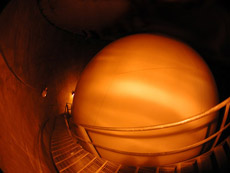
"Final Theory," a new book by Scientific American writer Mark Alpert, spins a science fiction tale, while giving brief physics lessons along the way. As part of his research, Alpert toured Fermilab experiments, including MiniBooNE, pictured here.
In Mark Alpert's book "Final Theory," released June 3, Fermilab provides the setting for a climactic battle between good and evil over finding Albert Einstein's Theory of Everything.
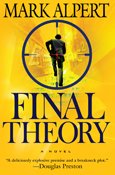 |
| Scientific American writer Mark Alpert's new book, "Final Theory," involves Fermilab and high-energy physics. |
The idea for the novel sprang from research Alpert was doing on Einstein for Scientific American, and from a trip to Fermilab to research a story on neutrinos. Alpert was wowed by the different approaches to physics beyond the Standard Model, the current recipe for matter and the forces of nature.
At the energy frontier, the Tevatron and its detectors produce and analyze sprays of millions of particles each second from collisions at nearly the speed of light. The particles could hold the key to extra dimensions and new never-before-seen constituents of matter.
At the intensity frontier, Alpert toured the BooNE/MiniBooNE experiment. Neutrinos and their antiparticles could be the key to a universe made entirely of matter.
"In the back of my mind, I was thinking this is great thriller material. It is very James Bond. There is so much going on here," Alpert said. "I really had so much fun on the tour and the excitement that is going on there. I tried to inject that into the book."
"I was just so impressed with the Tevatron," said Alpert in choosing Fermilab as the setting. "Until the LHC comes on, this is the most powerful (accelerator) in the world, and there may still be some amazing physics to come out of here in the next few years."
The Tevatron control room, CDF collision hall, accelerator tunnels, Wilson Hall and MiniBooNE's 40-foot-diameter detector create, unique settings for the book.
"I tried really hard to make it accurate, but for narrative reasons I changed little stuff," he said.
--Tona Kunz
Read the full article on the symmetry breaking blog.
|
At the end of the rainbow
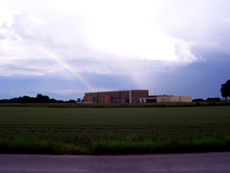
CMS collaborator Mark Ruschman submitted this photo of two rainbows ending at CERN's Point 5 (CMS). "There is something far more valuable than a mere pot of gold at the end of the rainbows!" Ruschman said.
|
Physicists in Congress calculate their influence
From New York Times, June 10, 2008
According to the Congressional Research Service, there are only about 30 scientists among the 535 senators and representatives in the 110th Congress, and that is counting the psychologist, the psychiatrist, a dozen other M.D.'s, three nurses, an engineer, two veterinarians, a pharmacist and an optometrist.
But physics is on a roll.
"Go back 15 years, and there weren't any physicists," said Vernon J. Ehlers, a Republican who taught the subject at Calvin College in Grand Rapids, Mich., until he was elected to Congress in 1993.
His was a lone voice until 1998, when Rush Holt, assistant director of the Princeton Plasma Physics laboratory, won election from New Jersey as a Democrat. And today there are three, adding Bill Foster, a physicist at Fermilab and another Democrat, who won a special election in March in Illinois.
"If we continue to reproduce in this manner," Mr. Foster began, and Mr. Ehlers finished the thought, "the entire Congress would consist of physicists!"
Read more
|
Batavia laboratory contributes key component of NASA telescope
From Chicago Tribune, June 12, 2008
Box zeros in on gamma rays
Fermilab has sought for years to penetrate the secrets of the universe, exploring mysteries of the physics that led to atoms, stars and galaxies.
But on Wednesday the earthbound laboratory in Batavia found its handiwork floating in space for what officials believe is the first time. The lab contributed a key component of National Aeronautics and Space Administration's Gamma-ray Large Area Space Telescope (GLAST), which was launched into orbit by a Delta II rocket from Cape Canaveral, Fla.
The GLAST-now orbiting 350 miles above Earth, circling the planet every 90 minutes-is a powerful space observatory that will study the most extreme environments in the universe, including pulsars and supermassive black holes that fire jets of material at nearly light speed, scientists say.
Read more
|
|
|
Hungry for the Higgs
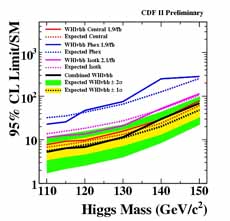
The diagram shows the limit of Higgs production (at 95 percent confidence level) for different potential Higgs masses. The blue, pink and red lines show the limits in the three separate lepton channels. In earlier versions of the analysis, the only channel was the central leptons, shown in red. The two new channels are forward electrons, shown in blue, and isolated tracks, shown in pink. The black line shows the limit for combining all lepton channels. The new lepton categories provide a combined 20 percent improvement in the limit.
Finding the Higgs boson is a top priority at the Tevatron right now. Many different groups are working day and night to try to catch a glimpse of the elusive particle. One group of CDF physicists has recently added previously unused collision data to its search. Including these extra events significantly increased the chance of finding Higgs bosons.
To find the Higgs, the CDF team looks for collisions that produce a Higgs boson with a W boson. When the W boson decays to a lepton (electron or muon) and a neutrino, it provides a distinct signature that helps distinguish Higgs events from background events. By using new triggers and techniques, the CDF team was able to use leptons, from the W decays, that are not detected by the central muon chambers. These events previously went unused, as they are more challenging to analyze. Like potato-chips crumbs, such events are harder to collect than the larger chips, but they taste just as good!
Since the proton-antiproton collisions created by the Tevatron have a tiny chance of producing a Higgs boson, scientists want to record and analyze as many of these rare events as possible. The improvements made by the CDF team increase the potential yield for Higgs events with W bosons by 35 percent.
Although the excluded cross section is still a factor of six away from the expected Standard Model Higgs cross section, this new technique improves the sensitivity of this analysis by 20 percent. As Fermilab continues to take data, improvements like these, spread over several analyses at both CDF and DZero, will be key to eventually solving the mystery of whether the Higgs boson really exists.
Learn more
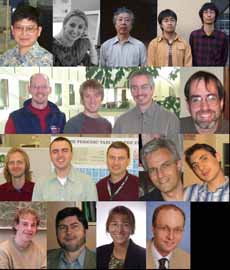
From top left:
Wei-Ming Yao, LBNL; Anyes Taffard, UC Irvine; Shinhong Kim, Tatsuya Masubuchi and Yoshikazu Nagai, University of Tsukuba; Richard Hughes, Jason Slaunwhite, Brian Winer, Kevin Lannon, Ohio State University;
Nils Krumnack, Martin Frank and Jay Dittmann, Baylor University; Andreas Warburton and Adrian Buzatu, McGill University; Thomas Peiffer, Thomas Muller, Jeannine Wagner-Kuhr and Wolfgang Wagner, University of Karlsruhe.
Result of the Week Archive
|
|
Have a safe day!
NALWO sponsors wildlife talk
Fermilab's women's organization NALWO will sponsor "Wildlife on the Prairie," a talk by lead groundskeeper Jim Kalina at 10 a.m. on Thursday, June 12. Kalina will share stories about coyotes, deer, American bison and other wildlife that have made their homes here at Fermilab. The informal talk will take place near the picnic tables at Kuhn Barn or inside the barn if it rains. Anyone can attend. Please show photo ID to enter the laboratory.
International Folk Dance Thursday
International Folk Dancing will move to Ramsey Auditorium for the summer beginning Thursday, June 10. Dancing begins at 7:30 p.m. with teaching and children's dances earlier in the evening and request dancing later on. For more information, call (630) 584-0825 or (630) 840-8194 or e-mail.
Special discount on SciTech
summer camps
The SciTech hands-on Children's Museum in Aurora offers all Fermilab
employees discounts on its Science Adventure summer camps, honoring the
long-standing relationship between the two organizations. The week-long
camps begin on June 23 and run from 9 a.m. to 3 p.m. with before and after
care available from 8 a.m. to 5 p.m. Fermilab employees only pay from $174
to $199 and the before and after care is free. Visit the SciTech Web site to register. (Do not use the Web
site to sign up for before and after care. SciTech will call you to confirm
whether you want this service.) To receive your discount enter the code
FERMI2008 on checkout.
Additional Activities |
|